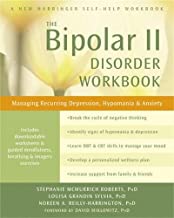Bipolar II
Resources for Patients and Caregivers
A type of bipolar disorder characterized by depressive and hypomanic episodes.
It involves at least one depressive episode lasting at least two weeks and at least one hypomanic episode lasting at least four days.
Depressive symptoms include sadness or hopelessness. Hypomanic symptoms include a persistently elevated or irritable mood.
Treatment includes counseling and medications, such as mood stabilizers.
Cluster Number:
Wiki Number: 09-Bipolar II
Diagnosis: One or more long sessions of depression, some hypo(lower)mania, but no full manic session
US Patients:
World Patients:
Sex Ratio:
Age Onset:
Brain Area:
Symptoms: May be more chronic and recurring in the depressive phase than Bipolar I.
Progression: May be a high risk of suicide. 25-50% of Bipolar II patients make at least one suicide attempt.
Causes:
Medications: Can be modified by several medications.
Therapies:
Youtube Video: Bipolar 1 or Bipolar 2 Disorder – Which is Worse?
Amazon or Library Book: Bipolar II Disorder Workbook
Click the book to link or order from Amazon.

